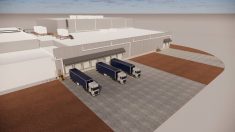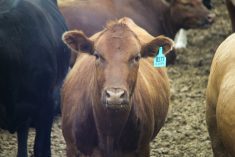The idea is appealing: Imagine moving your cattle from the comfort of your armchair or while you’re away from the ranch.
And it could become reality, says a University of Alberta professor who is testing Nofence collars, a product that its Norwegian maker bills as “the world’s first virtual fence for livestock.”
“We see a lot of potential for these collars,” said Edward Bork, who is also director of the university’s Rangeland Research Institute.
Read Also

Moo translator and methane measures: There’s an app for that
Dalhousie University researchers use artificial intelligence to create new dairy farm apps that analyze cattle sounds and measure methane.
“You could move them from your pickup truck — or your living room or your kitchen.”
The collars work on the same principle as those used for dogs: Get too close to the virtual boundary set by a global positioning system (GPS) and a chime sounds. Cross the boundary and the collar produces a weak electric shock.
But keeping a pet in the yard is one thing, controlling cattle on pasture is a whole other ballgame.
“There are a lot of producers in Europe who are successfully using virtual fencing right now,” said Alexandra Harland, a master’s student working with Bork who tested the collars at the Roy G. Berg Kinsella research farm.
“My research is really focusing on the practicality of using these collars in an Alberta landscape. There are definitely some challenges that would come with wanting to start using these collars.”
One is a sort of bovine version of the ‘range anxiety’ that electric car owners experience — you don’t want the herd busting loose because the batteries in the collar died.
But so far, the two solar panels on the collar seem up to the job of keeping the lithium battery charged.
“They appear to be able to handle the extreme conditions, the short daylight and cold temperatures that we have here in Alberta,” said Bork. “Even in that really cold period of December, they kept running. The battery readings that we saw when we were looking at them online had dropped to about 80 per cent. But once it warmed up, they actually rebounded.”
The box containing the GPS antenna hangs from the collar by two chains (which deliver a shock that’s about a quarter of what an electric fence would).
“The GPS uses satellites to track in real-time, where that animal is throughout the day and night,” said Bork.
The second part of the system is a mobile app that works on a cell phone.
“The app is where you have the control centre,” said Harland. “You can use the app to basically create virtual pasture boundaries.”
“The collar downloads the new boundary and then uses that as the reference for containing the animal,” added Bork.
When using the app, the user sees a satellite-view map. The boundaries are made by creating fence posts, and then dropping and dragging them.
“You can easily create all sorts of oddly shaped pastures,” she said.
And you can also see where every animal is in the field.
“You basically have an app that allows you to go in and see where that animal is at any point in time,” said Bork.

But, not surprisingly, you need a strong internet connection to make those two features work.
“The collar system can operate without internet,” said Harland. “But if you want to do any sort of rotational grazing, if you want to change pastures or edit pastures, if you want to receive notifications about shocks or escapes, and if you want to be able to monitor your cattle in real-time, you need an internet connection, both where the collars are and where your cellphone is.”
Animals that are using virtual fencing also need to be trained.
“You don’t just deploy these collars and say, ‘Have at it’,” said Bork.
He and Harland trained the animals by using a physical fence and creating a virtual fence that matches it. When the animal approaches the buffer fence, they get an audio warning (a chime) from the collar. If they don’t leave the area, they get a shock.
To test the collars, the researchers would take large paddocks and break them into several smaller ones with one true, fully virtual fence line to go through it. They then tracked how many animals cleared the fence.
When they wanted to rotate, they moved the virtual fence, and the animals moved.
“You can rotate animals quite effectively,” said Bork. “By the end of the summer, the animals were figuring out how to work the audio tone, which is really cool. They would work the boundary. They could see the green grass, would walk a little bit into the virtual fence, and grab a bit of food and then walk back.”
The researchers also tried grazing paddocks with no water, creating corridors to the water source.
“You can actually create corridors for them to access water,” he said. “You can do some really innovative things with this fencing over time.”
Another big hurdle is cost — $350 for a single collar — although that might come down as the technology becomes more commonplace.
The University of Alberta is doing the largest study on the Nofence collars, but Lakeland College and Olds College have been experimenting with some collars.
Last summer, Harland successfully rotationally grazed 49 heifers and two bulls using a virtual fencing system. This year, the researchers are hoping to run a trial with cow-calf pairs.
“That’s the interesting one because you don’t want to put the collars on a calf,” said Bork. “What we would probably do is look at the fidelity of the cow to the pasture, knowing the calf could serve as a distraction to lure them out.”
















